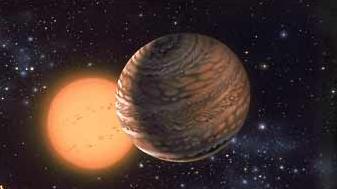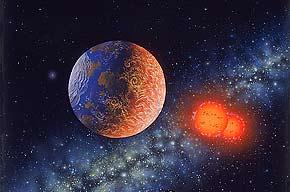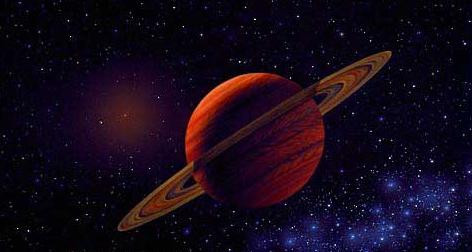When is a star too small?
 Red Dwarfs. The smallest stars
Red Dwarfs. The smallest stars
Astronomers define a star to be an object that has sufficient pressure and
temperature at its core to fuse Hydrogen into Helium. The smallest stars have
at least 8% the Sun's mass (or 80 Jupiter Masses. DEFINITION: Sun mass = 1000 Jupiter masses)
and are called Red Dwarfs. One interesting
system, Gliese 876b, shown to the right in an artist's sketch, is a binary system of a Red Dwarf with a 2.1 MJUP
Planet.
Brown Dwarfs.
Brown Dwarfs are neither full-fledged stars nor are they planets. They have
masses < 8% of the Sun and are unable to fuse hydrogen in their cores.
However, they are formed and behave somewhat like stars. They glow like stars,
but their energy is created from their gravitational collapse. Jupiter is also
glowing, a little bit, from such energy release.

Further division is based on their formation. Brown Dwarfs would be central to a single solar-nebula. Planets form from the left over accretion material in the solar-nebular. This distinction is not always easy to resolve. In the example to the right, there is a binary of two red dwarfs, around which a planet has also formed. If one of the red dwarfs' mass was just below the fusion cut off, would it be a planet or a brown dwarf?
The dividing line has been (a bit arbitrarily) drawn: objects 10 - 80 MJUP (1 and 8% the mass of the Sun) are Brown Dwarfs. Objects below 10 MJUP are planets.
 Planets
Planets
Planets down to the size of Saturn have recently been found. This is still
a long way from detecting Earth size planets (another 95x in mass). The image to
the right is an artists conception of the Lalande 21185 system, a red dwarf with
a fairly distant Saturn-like planet.